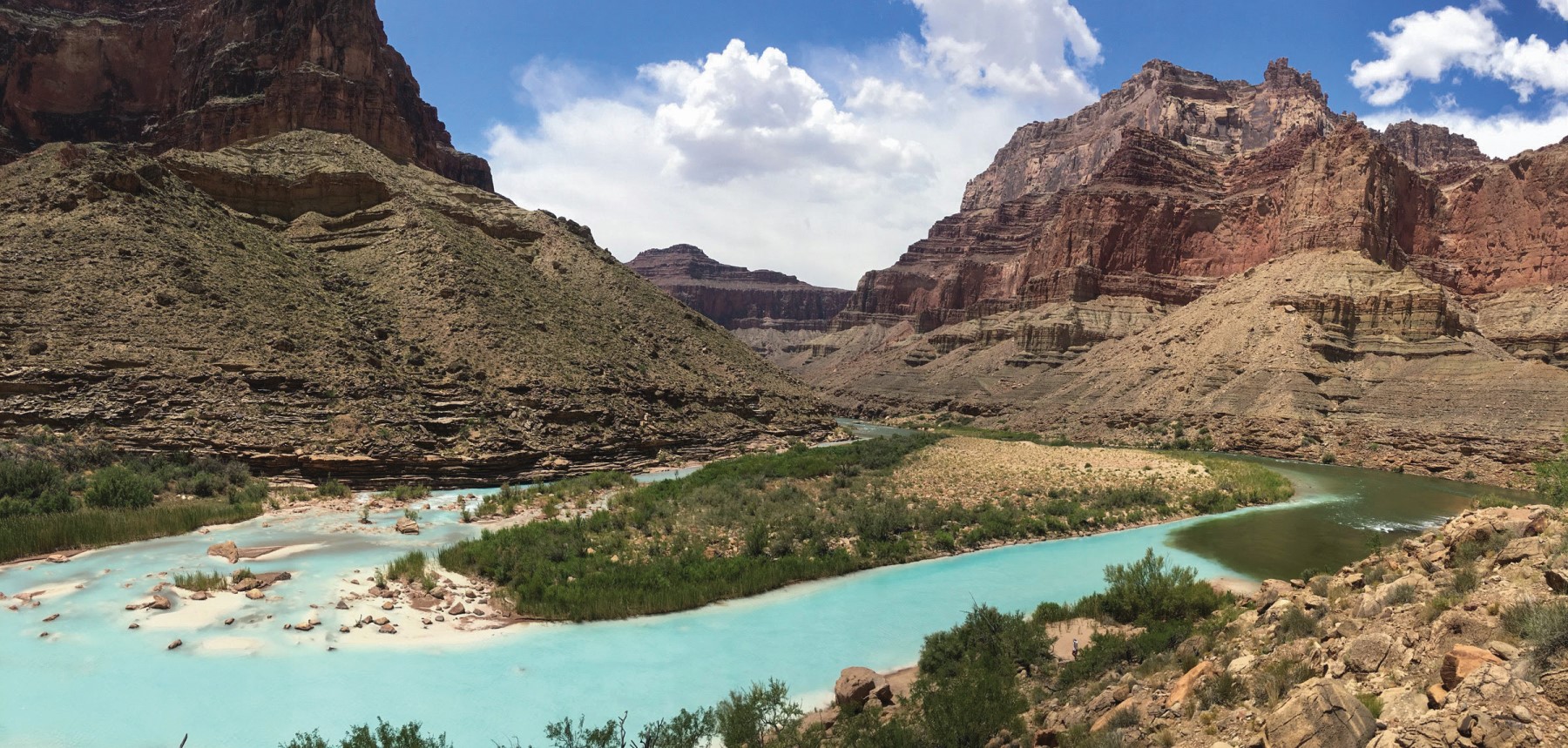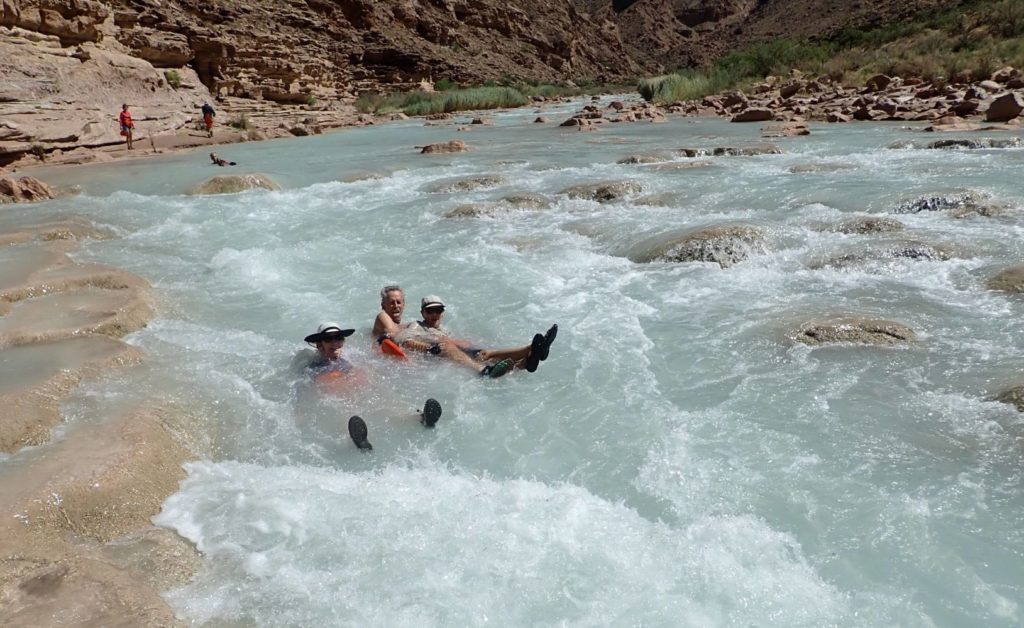
Little Colorado River
Grand Canyon
The Little Colorado River (aka LCR) is the largest tributary to the Colorado River within Grand Canyon. Almost 340 miles long, the Little Colorado stretches through Arizona across the Navajo Nation starting in western New Mexico. The LCR holds significance to many groups in the region and makes a popular stop for those visiting from outside the area.
Spiritual Significance of the LCR
Several Native American tribes consider the Little Colorado River a deeply spiritual place. The Hopi tribe believe that their ancestors emerged from the underworld at the Sipapu, a landmark on the Little Colorado River. This is considered the original home of the tribe. The Hopi people also believe that their spirits live among the Grand Canyon, particularly in the clouds above it. “The Grand Canyon and humanity are all one,” said Leigh Kuwanwisiwma, former director of the Hopi Cultural Preservation Office. The trail into the canyon here is called the Hopi Salt Trail.
The Little Colorado currently marks the home of the Navajo people. The confluence is sacred to them, as they pray there. Within the Navajo Nation there is continuing conflict regarding the building of a resort and tram in this are. Learn more about this and other threats to the LCR. In addition, this tributary also holds deep meaning to the Zuni people. They believe that their ancestors first appeared on Earth near the confluence and they then traveled along the Little Colorado to find their home.
Native Humpback Chub
Along with the native people of this area, the Little Colorado River is home to the endangered humpback chub. These impressive creatures can survive muddy waters, floods, and the most technical rapids in the Grand Canyon. This species has lived in this tributary for 3.5 million years. However, the damming of the Colorado River at Glen Canyon has caused the Colorado River to become much clearer and colder than it was historically. This has put the chub at a competitive disadvantage with the introduced trout that thrive in these conditions. Fortunately, the Little Colorado remains warmer providing a safe haven for the humpback chub.
Milky, Blue Waters
The turquoise blue waters of the Little Colorado River are one of its most distinctive features. Like Havasu Creek, the electric blue color is a result of the magnesium and calcium in the water, combining with the carbon dioxide in the air, creating calcium carbonate. This combination of minerals reflect the sunlight, creating, arguably, the most beautiful water in the world. It is quite the site, to see the bright blue waters of the Little Colorado flow into the either dark emerald or chocolate-y brown waters of the Colorado.
The blue waters of the LCR originate in underground aquafers where the minerals are absorbed into the water. At the Sipapu and other springs, the water comes to the surface a flows from there down to the Colorado River. The Little Colorado only shows its blue water when there have been no recent rains in the drainage that cause the river to turn muddy. The LCR commonly turns the main stem of the Colorado River muddy brown during the summer.
Seeing the LCR
The main ways people experience the Little Colorado is a view from above or hiking up from the bottom. It is possible to drive to the rim for a look or take a flight over Grand Canyon for a view. Many people also see the Little Colorado River Canyon by hiking up from the Colorado River on a rafting trip. A very few actually hike down into the canyon.
Viewing the Little Colorado from Above
The most popular viewpoint on the rim is the Little Colorado Gorge on state route 64 between mile markers 285 and 286. There are lots of Navajo jewelry stands surrounding this area, so there are many opportunities to shop and support the locals. There are other viewpoints, outside of Cameron. More information can be found at the Navajo Park and Recreation Visitor Center.
Video: Little Colorado River Gorge
A nice stop just outside of the town of Cameron is the Little Colorado River Gorge Overlook.
Plane Tours
Plane and helicopter tours of Grand Canyon fly over the Little Colorado River providing a view of its confluence with the Colorado River. Check out aerial tours and other attractions near Grand Canyon.
Rafting for an Up Close View of the Little Colorado
If you want to see the creamy, blue waters of the Little Colorado up close, there are a few options. Unfortunately, the trails are all quite remote. By far the easiest method is to rafting down from Lees Ferry and stopping at the confluence for a hike up the LCR. The one problem with this is many times the Little Colorado will be running brown particularly during the monsoon season of July and August.
Hiking to the Colorado River
This area of Grand Canyon is extremely remote, making the physically challenging hiking that much more dangerous.
Salt Trail
Getting to this trailhead requires heading North of Cameron on US-89. Then, you take a left on Indian Route 6130, a fairly well-maintained dirt road across the Navajo Tribal Park. You are on this road for 15 miles to the trailhead. Now comes the hard part: the 3-mile descent into the Canyon. Three miles may seem like cake to experienced hikers, but in this case, it is important to remember that not all miles are created equal. You will drop 2,750 ft. in elevation over these 3 miles, resulting in very steep sections of trail. Paying attentions to cairns is essential, as the route is not clear. Hike Arizona has an excellent description of the Salt Trail.

Backpacking Down the Tanner Trail & Across the Beamer Trail
This option requires more time and planning with multiple itineraries available. Permits need to be purchased through the National Park Service. Ultimately, you will descend 9 miles into the canyon on the Tanner trail, dropping a total of 4,650 ft in elevation. Your most convenient option for the night is staying at Tanner Beach.
For day two I would recommend as a rest day, requiring a docile 2.9-mile hike to Palisades Creek. Set up camp here, go for a swim, make a quesadilla, and relax. Day three: pack your essentials for a long day hike. You will be embarking on the Beamer Trail for 6.2 miles to the Little Colorado. The Beamer trail can be daunting in that it can be rather narrow with lots of exposure over the booming Colorado River. However, once overcome, your destination is impeccable. You will then find yourself on the banks of the confluence. Enjoy your time!
Route-Finding the Walter Powell Route
Please be advised that is is considered an extremely difficult route and should only be attempted by highly experienced backpackers. This route must be accessed on the Navajo Nation and hiking and camping permits are required. Walter Powell was part of a Colorado River expedition in 1869. The crew of pioneers faced much adversity on their journey, including losing a boat, containing a third of their food. When the group reached the confluence, Walter Powell decided to scramble his way to the rim.
He succeeded in his mission, resulting in this mysterious route. Getting to the “trailhead” requires a 60+ mile drive down numerous dirt roads on the Navajo reservation. Then, you must find the route itself. Expect no signs; you will be doing the route-finding. This route is only a little over a mile from the rim to the LCR and then an additional 1.3 miles to the Colorado River, however, it is a 3,400 ft drop in elevation. Andy Lewicky wrote his personal experience on this route.
Concluding Thoughts
No matter the route, visiting the Little Colorado River provides for a memorable experience with it’s Caribbean blue waters during certain times of year. Conveniently, it simultaneously provides shelter to the ancient, endangered humpback chub. In addition, it contains cultural and religious significance to the native people of this area. Lastly, it is an oasis in the desert, providing hope for many.




